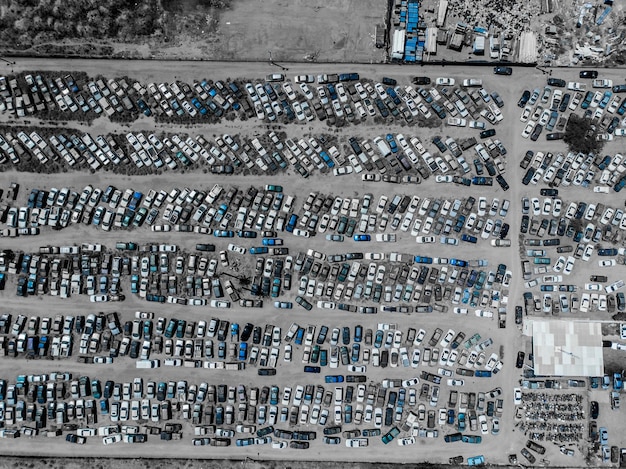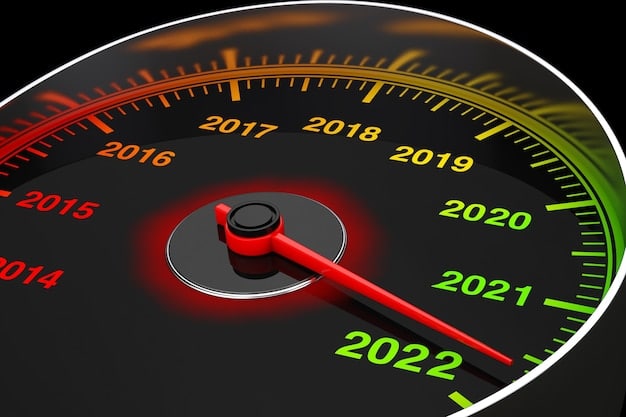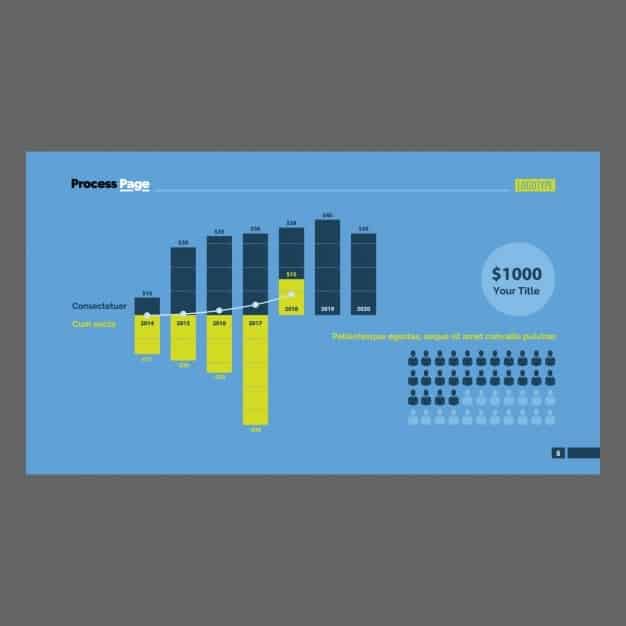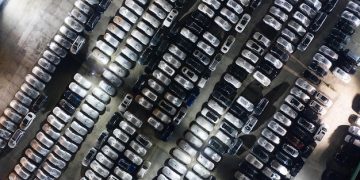New Federal Fuel Efficiency Standards 2025: Automakers’ Key Implications

The key implications of the new federal fuel efficiency standards for automakers in 2025 involve significant investments in electric vehicle (EV) technology, potential shifts in production strategies, and adaptation to evolving consumer demands to meet stringent emissions targets.
The automotive industry is on the cusp of a transformative era, largely driven by the latest federal mandates on fuel efficiency. Understanding the key implications of the new federal fuel efficiency standards for automakers in 2025 is crucial for navigating the road ahead.
What are the 2025 Federal Fuel Efficiency Standards?
The 2025 federal fuel efficiency standards represent a significant tightening of regulations aimed at reducing greenhouse gas emissions from vehicles. These standards are designed to push automakers toward producing more fuel-efficient vehicles, including hybrid and electric models, and away from traditional gasoline-powered cars.
The Corporate Average Fuel Economy (CAFE) standards, administered by the National Highway Traffic Safety Administration (NHTSA), and the emissions standards, overseen by the Environmental Protection Agency (EPA), work in tandem to set these targets. Automakers must meet these requirements across their entire fleet of vehicles sold in the United States.

Understanding CAFE and Emissions Standards
The CAFE standards mandate a certain miles-per-gallon (MPG) average for each automaker’s fleet. This means that the average fuel economy of all vehicles an automaker sells must meet or exceed the set MPG target for that year. Failure to comply can result in hefty fines.
Emissions standards, on the other hand, focus on limiting the amount of pollutants, such as carbon dioxide (CO2), that vehicles can emit per mile. The EPA sets these standards, and automakers must ensure their vehicles comply to avoid penalties.
- CAFE Standards: Focus on improving the average fuel economy of vehicles.
- Emissions Standards: Aim to reduce the amount of pollutants emitted by vehicles.
- Compliance: Automakers must meet both standards across their entire fleet.
These increasingly stringent standards push automakers to innovate and invest in new technologies, like electric powertrains and lightweight materials. The ultimate goal is to reduce the environmental impact of the transportation sector.
Investment in Electric Vehicle (EV) Technology
One of the most significant implications of the new fuel efficiency standards is the need for automakers to invest heavily in electric vehicle (EV) technology. To meet the 2025 standards, companies must increase the proportion of EVs in their product lineups.
This shift requires substantial investment in research and development, as well as in manufacturing infrastructure. Automakers must develop new EV platforms, improve battery technology, and establish charging networks to support EV adoption.
R&D and Manufacturing Investments
Investing in research and development is crucial for advancing EV technology. This includes improving battery energy density, reducing charging times, and enhancing the overall performance and range of electric vehicles. Automakers are pouring billions of dollars into these efforts.
Significant investments are also needed in manufacturing facilities to produce EVs at scale. This involves retooling existing factories or building new ones to accommodate EV production, including battery manufacturing and assembly lines.
- Battery Technology: Developing more efficient and cost-effective batteries.
- Charging Infrastructure: Building out public and private charging networks.
- Production Capacity: Scaling up EV production to meet demand.
These investments not only help automakers meet regulatory requirements but also position them to capitalize on the growing demand for electric vehicles. The transition to EVs is a long-term strategy that requires sustained financial commitment.
Production Strategy Shifts
Meeting the 2025 fuel efficiency standards requires automakers to rethink their production strategies. They need to balance the production of fuel-efficient vehicles, including EVs and hybrids, with traditional gasoline-powered models.
This often involves phasing out less fuel-efficient models and introducing more hybrid and electric options. Automakers may also need to limit the production of larger, less efficient vehicles to offset their impact on overall fleet fuel economy.

Balancing Production with Fuel Efficiency
Automakers must carefully manage their production mix to ensure compliance with the CAFE standards. This involves optimizing the production of different vehicle types based on their fuel efficiency ratings.
Producing more EVs and hybrids helps to balance out the less fuel-efficient models in the fleet. Automakers are also exploring strategies like downsizing engines and using lighter materials to improve the fuel efficiency of their gasoline-powered vehicles.
- Fleet Mix: Optimizing the ratio of fuel-efficient vehicles to less efficient ones.
- Downsizing Engines: Using smaller, more efficient engines in traditional vehicles.
- Lightweight Materials: Incorporating materials like aluminum and carbon fiber to reduce vehicle weight.
These shifts in production strategy are crucial for automakers to avoid penalties and remain competitive in a market that is increasingly focused on fuel efficiency and sustainability.
Adapting to Consumer Demands
The success of automakers in meeting the 2025 fuel efficiency standards also depends on how well they adapt to evolving consumer demands. As fuel efficiency and environmental concerns become more prominent, consumers are increasingly interested in purchasing fuel-efficient vehicles.
Automakers need to understand these changing preferences and offer products that meet consumer needs while also complying with regulatory requirements. This involves educating consumers about the benefits of fuel-efficient vehicles and offering competitive pricing.
Understanding Changing Preferences
Consumers are becoming more aware of the environmental impact of their vehicle choices. This is driving increased demand for fuel-efficient vehicles, including EVs and hybrids. Automakers need to understand these trends and tailor their product offerings accordingly.
Factors such as fuel prices, government incentives, and growing awareness of climate change are all influencing consumer preferences. Automakers must monitor these factors and adjust their strategies to stay ahead of the curve.
- Fuel Prices: Higher fuel prices drive demand for more fuel-efficient vehicles.
- Government Incentives: Tax credits and rebates can encourage consumers to purchase EVs.
- Environmental Awareness: Growing concern about climate change influences vehicle choices.
By adapting to consumer demands, automakers can not only meet the 2025 fuel efficiency standards but also build a loyal customer base that values sustainability and innovation.
Infrastructure and Supply Chain Challenges
Meeting the 2025 fuel efficiency standards is not just about technology and production strategies; it also involves addressing infrastructure and supply chain challenges. The widespread adoption of EVs requires a robust charging infrastructure, and automakers need to work with governments and other stakeholders to build out this infrastructure.
Supply chain issues, particularly related to battery components and raw materials, can also impact automakers’ ability to meet production targets. Diversifying sourcing and managing supply chains effectively are critical.
Building a Robust Charging Infrastructure
A lack of convenient and reliable charging infrastructure can be a major barrier to EV adoption. Automakers need to invest in building out public charging networks and supporting the installation of home chargers.
This involves working with governments to secure funding and streamline permitting processes. Standardizing charging protocols and ensuring interoperability between different charging networks are also important considerations.
- Public Charging Networks: Expanding the availability of public charging stations.
- Home Charging Solutions: Supporting the installation of home chargers.
- Standardization: Ensuring compatibility between different charging systems.
Addressing these infrastructure challenges is essential for supporting the widespread adoption of EVs and enabling automakers to meet the 2025 fuel efficiency standards.
Potential Economic Impacts
The new federal fuel efficiency standards could have significant economic impacts on the automotive industry and the broader economy. The investments required to meet these standards could lead to higher vehicle prices, but they could also create new jobs in the EV sector.
The transition to EVs could also reduce the demand for gasoline, impacting the oil industry. The overall economic effects will depend on how quickly and smoothly automakers can adapt to the new standards.
Job Creation and Vehicle Costs
The shift to EV production could create new jobs in areas such as battery manufacturing, charging infrastructure installation, and EV maintenance. However, it could also lead to job losses in traditional automotive manufacturing as gasoline-powered vehicle production declines.
The cost of EVs is currently higher than that of comparable gasoline-powered vehicles, but prices are expected to decline as technology improves and production scales up. Government incentives can also help to make EVs more affordable for consumers.
- New Job Opportunities: Growth in the EV sector creates new employment prospects.
- Vehicle Pricing: EV prices are expected to decrease over time.
- Economic Transition: The shift to EVs could impact various sectors of the economy.
Understanding these potential economic impacts is crucial for policymakers and businesses as they plan for the future of the automotive industry in 2025 and beyond.
| Key Point | Brief Description |
|---|---|
| ⚡ EV Investment | Significant investments in EV technology and infrastructure required. |
| 🔄 Production Shifts | Balancing EV production with traditional gasoline vehicles. |
| 📈 Consumer Demand | Adapting to growing consumer interest in fuel-efficient vehicles. |
| ⛓️ Supply Chain Challenges | Managing supply chain issues for battery components and raw materials. |
Frequently Asked Questions (FAQ)
▼
CAFE (Corporate Average Fuel Economy) standards are regulations in the United States to improve the average fuel economy of cars and light trucks produced for sale in the U.S., established by the Energy Policy and Conservation Act of 1975.
▼
Emissions standards set limits on the amount of pollutants vehicles can emit. Automakers must comply by developing cleaner technologies and facing potential fines for non-compliance, impacting their R&D and production strategies.
▼
Investing in EV technology is essential for automakers to meet stringent fuel efficiency standards, attract environmentally conscious consumers, and remain competitive in a market that increasingly favors electric vehicles and sustainable options.
▼
Supply chain challenges include securing reliable sources of battery components like lithium and cobalt, managing disruptions from geopolitical tensions, tariffs, and ensuring ethical sourcing as demand for EVs grows rapidly.
▼
Consumer demands are shifting toward fuel-efficient and environmentally friendly vehicles. Factors like rising fuel costs, awareness of climate change, and government incentives are driving preference for EVs and hybrid models.
Conclusion
The new federal fuel efficiency standards for 2025 present both challenges and opportunities for automakers. By investing in EV technology, adapting production strategies, and understanding consumer demands, companies can navigate the changing landscape and position themselves for success in the evolving automotive industry.





